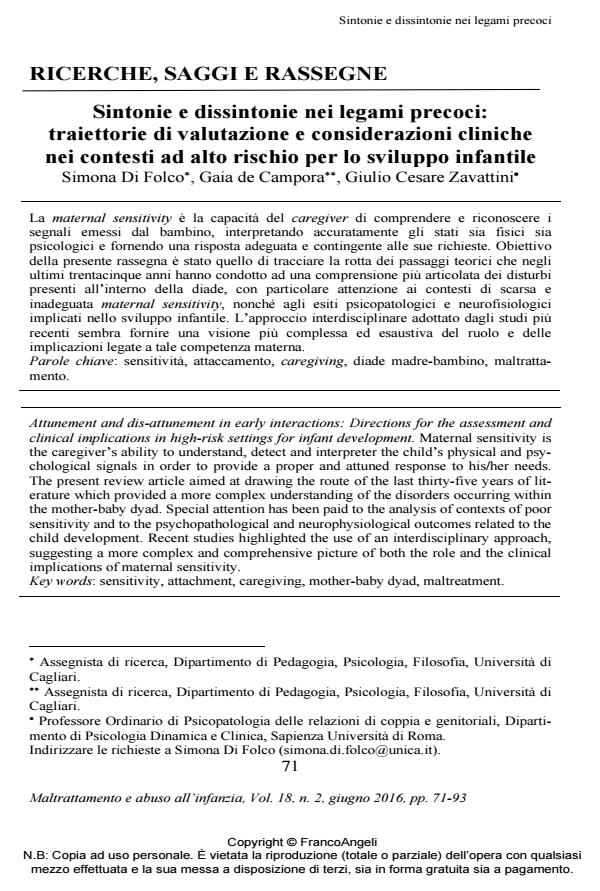Attunement and dis-attunement in early interactions: Directions for the assessment and clinical implications in high-risk settings for infant development
Journal title MALTRATTAMENTO E ABUSO ALL’INFANZIA
Author/s Simona Di Folco, Gaia de Campora, Giulio Cesare Zavattini
Publishing Year 2016 Issue 2016/2
Language Italian Pages 23 P. 71-93 File size 257 KB
DOI 10.3280/MAL2016-002005
DOI is like a bar code for intellectual property: to have more infomation
click here
Below, you can see the article first page
If you want to buy this article in PDF format, you can do it, following the instructions to buy download credits

FrancoAngeli is member of Publishers International Linking Association, Inc (PILA), a not-for-profit association which run the CrossRef service enabling links to and from online scholarly content.
Maternal sensitivity is the caregiver’s ability to understand, detect and interpreter the child’s physical and psychological signals in order to provide a proper and attuned response to his/her needs. The present review article aimed at drawing the route of the last thirty-five years of literature which provided a more complex understanding of the disorders occurring within the mother-baby dyad. Special attention has been paid to the analysis of contexts of poor sensitivity and to the psychopathological and neurophysiological outcomes related to the child development. Recent studies highlighted the use of an interdisciplinary approach, suggesting a more complex and comprehensive picture of both the role and the clinical implications of maternal sensitivity.
Keywords: Sensitivity, attachment, caregiving, mother-baby dyad, maltreatment
- Parents' Psychological Factors Promoting Children's Mental Health and Emotional Regulation During the COVID-19 Lockdown Mara Morelli, Elena Cattelino, Roberto Baiocco, Emiddia Longobardi, Carmen Trumello, Alessandra Babore, Carla Candelori, Antonio Chirumbolo, in MALTRATTAMENTO E ABUSO ALL'INFANZIA 1/2021 pp.47
DOI: 10.3280/MAL2021-001004 - Il trauma psichico fra psicoanalisi e Infant Research Valentino Ferro, in MALTRATTAMENTO E ABUSO ALL'INFANZIA 1/2017 pp.85
DOI: 10.3280/MAL2017-001006 - La strutturazione del legame di attaccamento in minori esposti a violenza domestica Paola Miano, Federica Astorino, in MALTRATTAMENTO E ABUSO ALL'INFANZIA 2/2017 pp.81
DOI: 10.3280/MAL2017-002005 - Sostegno precoce alla genitorialità: l'home visiting in un'esperienza territoriale Marianna Giordano, Gabriella Bismuto, Chiara Capasso, Maria Cristina Castaldo, Nicoletta Gasparini, in MALTRATTAMENTO E ABUSO ALL'INFANZIA 1/2017 pp.133
DOI: 10.3280/MAL2017-001008 - Mani che parlano: un'esperienza laboratoriale per "ricucire" le emozioni della propria storia Cecilia Ragaini, Angela Gammarano, Francesca Cerutti, Alessia Zangari, Federica Bianchi, Martina Branca, in MALTRATTAMENTO E ABUSO ALL'INFANZIA 1/2018 pp.93
DOI: 10.3280/MAL2018-001007 - Parental Attunement, Insightfulness, and Acceptance of Child Diagnosis in Parents of Children With Autism: Clinical Implications Magda Di Renzo, Viviana Guerriero, Giulio Cesare Zavattini, Massimiliano Petrillo, Lidia Racinaro, Federico Bianchi di Castelbianco, in Frontiers in Psychology 1849/2020
DOI: 10.3389/fpsyg.2020.01849
Simona Di Folco, Gaia de Campora, Giulio Cesare Zavattini, Sintonie e dissintonie nei legami precoci: traiettorie di valutazione e considerazioni cliniche nei contesti ad alto rischio per lo sviluppo infantile in "MALTRATTAMENTO E ABUSO ALL’INFANZIA" 2/2016, pp 71-93, DOI: 10.3280/MAL2016-002005